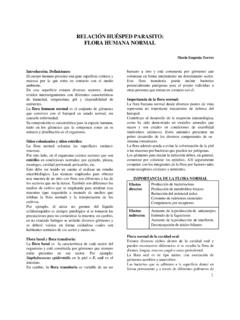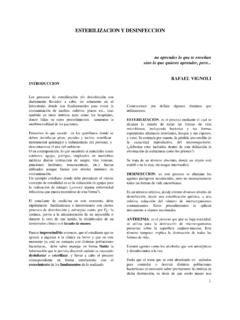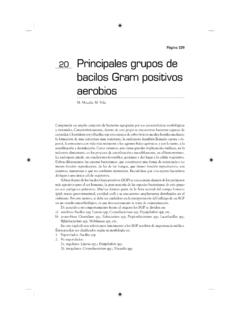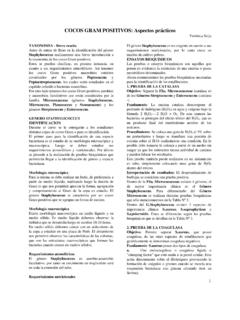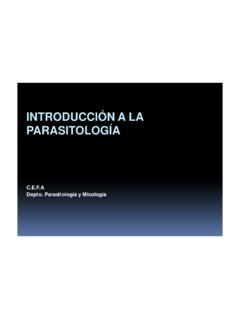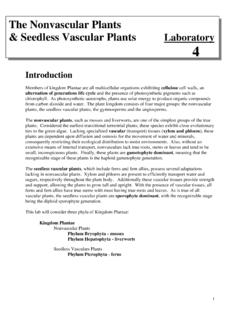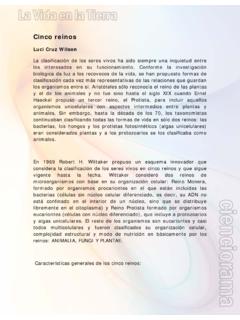Transcription of Protozoan Taxonomy and Systematics - UdelaR
1 Protozoan Taxonomy andSystematicsJohn O Corliss,University of Maryland, College Park, Maryland, USAT axonomy and Systematics of major groups of the Protozoa, an assemblage of so-calledlower eukaryotes, refer basically to the classification of such groups, that is, theirarrangement into a hierarchy of evolutionary interrelated groups (taxa) of scientificallynamed phyla, classes, orders, classification of protozoa and other microorganismsabove the organizational level of the bacteria has alwaysbeen dependent on microscopy because the body sizesinvolved generally range from only one micrometre to oneor two millimetres in length.
2 Any structures these speciespossess, useful in comparative studies of their morphologyand thus their Taxonomy and Systematics , are at the cellularand subcellular levels, and invisible to the naked eye. Thephysiological properties of protozoa (and the neighbour-ing algae )have also played a role in the classification ofthese ubiquitous eukaryotic microorganisms; and ofgrowing significance are the findings made possible byresearch using molecular biological we are continuing to learn more and more aboutsuch minute organisms, Protozoan Systematics that is,the Taxonomy (classification )and the evolutionary inter-relationships of major groups of protozoa remains atopic of debate and change, still today.
3 Some of the ratherlarge and unwieldy taxonomic groupings of past years areparticularly subject to revision with expansion of andrefinement in our knowledge about the members of those and related assemblages. Paradoxically, the protozoathemselves are becoming more difficult to define withprecision as our information about them and othermicrobial assemblages increases. Thus, presenting a singlesatisfactory circumscribed definition for them is not aneasy task. It is attempted towards the end of this article;but, for sake of clarity, further background information isfirst ConsiderationsUntil well beyond the middle of the twentieth century,protozoa were widely treated taxonomically as a (mere)subset of the kingdom Animalia, retaining their first-animal definition dating from 150 years earlier.
4 As aphylum of unicellular animals, they were thought to exhibitmajor characteristics typical of that kingdom: colourless( no photosynthetic pigments present; yet, incongru-ently, a goodly number of chlorophyll-possessing algalgroups were included in the phylum), phagotrophic, andcapable of independent locomotion. It is now abundantlyclear that this classical definition of protozoa is at bestmisleading and incomplete, and that it requires consider-able former times, zoologists were the principal investiga-tors and namers and claimers of such microorganisms;and they often worked with taxonomic disregard forstudies of what might actually be the same group,sometimes even the same species, by the botanists(phycologists and mycologists).
5 Thus, unfortunately,territoriality and authoritarianism also played major rolesin determining the early systematic status of the protozoa,algae and lower fungi (Corliss, 1986).Advances in our knowledge of the protozoa in generalhave followed progress in microscopy, as mentionedabove. As early as a century ago, novel improvements inmethods of light microscopy and related techniques offixing and staining were already beginning to makepossible the revelation of morphological cellular charac-teristics that would have remained totally unrecognizedbefore the appearance of such technological , at mid-twentieth century, the use of electronmicroscopical approaches in cell biology opened up awhole new epoch of exploration in protozoology andrelated fields.
6 During the Age of Ultrastructure (as it hasbeen called), a myriad of previously unknown subcellularstructures were revealed that became of immense value inthe comparative Taxonomy of the lower eukaryotes(especially protozoa and algae). Even more recently, theexciting development of molecular biological approaches,particularly in study of genealogical and phylogeneticrelationships within all groups of organisms, large andsmall, plant or animal, has offered a refinement intaxonomic investigations that is without parallel in an attempt is made to review and understand thesystematics of protozoa both from the more traditionalpoint of view, keeping in mind that many biologists are stillfamiliar mostly with older.
7 Conventional classifications ofthese minute organisms, and from more modern ap-Article ContentsSecondary Groups of Old Phylum Protozoa .Modern Options Concerning the Place of Protozoa inthe Biotic New Kingdom Protozoa 1 ENCYCLOPEDIA OF LIFE SCIENCES /&2001 Nature Publishing Group / The latter are complicated by the relativelyrecent advent of the protistological perspective lumpingprotozoa, algae and some other eukaryotic microorgan-isms together as Protista and by their usage of moresophisticated data.
8 For more detailed information con-cerning Protozoan protistan overlapping relationships,the reader is referred particularly to comprehensive papersby Cavalier-Smith (1993, 1998 )and Corliss (1994, 1998 )and to the insightful textbooks by Sleigh (1989 )andHausmann and Hu lsmann (1996).Major Groups of ProtozoaFor many decades (commencing with the perceptiveschemes of Otto Bu tschli, published in the 1880s), it hasbeen convenient to assign species known as protozoa to justfour major categories or assemblages, as has been done innumerous textbooks of biology and zoology as well asprotozoology.
9 Despite advances and improvements in ourknowledge of eukaryotic microorganisms in general, it isstill often rather helpful, for sake of discussion under diversecircumstances, to arrange protozoa taxonomically in such away. The categories generally recognized are: (1 )theamoeboid forms (the Sarcodina, in a broad sense); (2) theflagellated forms (the Mastigophora, including groups ofautotrophic or photosynthetic as well as heterotrophicspecies); (3) the ciliated forms (the Ciliophora, the moststable and perhaps most circumscribed of all protozoanassemblages).
10 And (4) the various totally symbiotic orparasitic forms (primarily spore-forming species that aretypically endoparasites, some highly pathogenic to theirhosts, once assigned to a very broad group called theSporozoa, a high-level taxon that subsequently becamedivided into the Sporozoa and the Cnidosporidia).One of the pedagogically oft-regretted but inevitablechanges, especially during the busy second half of thetwentieth century (even before the protist revolution : seeCorliss, 1986), was the tremendous expansion in the totalnumbers of high-level taxonomic groups (subphyla,classes, orders )of protozoa, while generally still recogniz-ing the four major top divisions mentioned above.



